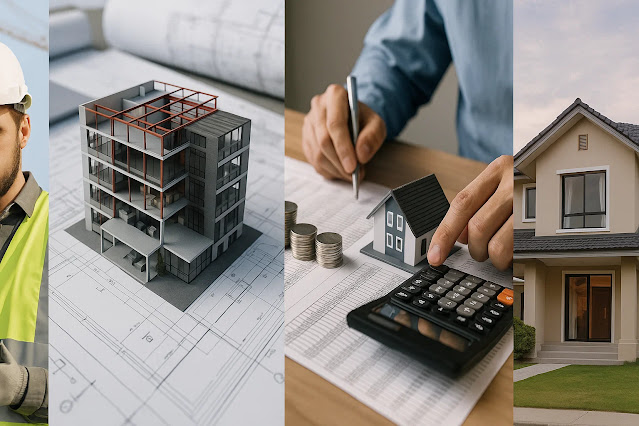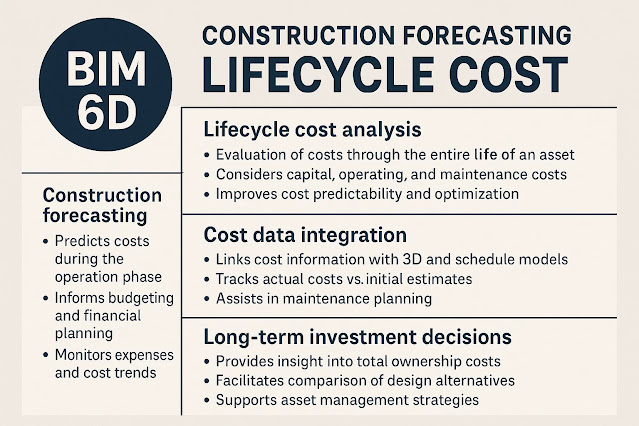Building Information Modeling (BIM) keeps growing, and now BIM 6D is grabbing attention, especially for its role in construction forecasting and lifecycle cost control. Facility managers, estimators, and project owners want more than just flashy 3D models. They need data that helps make smart decisions, saves money, and keeps buildings running smoothly across their lifespan. BIM 6D finally offers an approach that brings cost and operational performance into focus, changing how teams plan, build, and maintain facilities.
1. Understanding BIM 6D
BIM 6D goes beyond traditional 3D models by adding dimensions that support cost analysis and facility management. While BIM 3D shows shapes and spaces, and BIM 4D adds scheduling, and 5D adds cost estimation, BIM 6D makes that cost information dynamic and ties it directly to the actual building’s operation. With BIM 6D, teams manage not just how a building looks and gets built, but also how much it will cost over its entire lifecycle and how it will be maintained.
BIM 6D fits at the top of the BIM stack:
- 3D: Visual model
- 4D: Construction scheduling
- 5D: Cost estimation
- 6D: Lifecycle cost and facility management
Modern construction projects rarely end when the ribbon is cut. Ongoing costs, maintenance schedules, and energy use need attention. BIM 6D links all that information to the building model, creating a single source of truth.
2. BIM 6D and Cost Forecasting
BIM 6D brings a new level of confidence to construction forecasting. Accurate cost estimation becomes easier by integrating real-time data with detailed project models. Teams use live information on materials, labor, equipment, and overhead to get budget numbers that reflect both current prices and the building’s future needs.
Benefits of Cost Forecasting with BIM 6D:
- Improved budget accuracy: BIM 6D uses live data, so estimates are closer to what projects will truly cost.
- Early detection of cost overruns: Any changes ripple directly into the cost model, giving teams a heads-up before budgets get blown.
- Dynamic cost updates: As projects move from design to construction and beyond, cost models update automatically to reflect new data.
Common cost components in BIM 6D include:
- Material costs
- Labor expenses
- Equipment fees
- Overhead (admin, insurance, permits)
Cost Forecasting Across Project Phases
- Design phase: Modelers connect designs to cost databases for instant estimates.
- Construction phase: Real-time updates keep the team ahead of unexpected costs.
- Post-construction: Future repair and replacement costs feed into lifecycle models.
Tools like Autodesk BIM 360, Navisworks, and Revit now support cost forecasting workflows. Still, challenges remain. Data accuracy, integration between different software, and the need for trained staff can slow down adoption.
If you’re looking for deeper insights into the role of detailed modeling in cost planning, see this overview of structural steel detailing services and their impact on project budgets.
3. BIM 6D and Facility Management (FM)
Facility management is more than just keeping the lights on. It covers everything from maintenance scheduling to asset tracking and energy use. BIM 6D gives facility managers a live, centralized view of all building data, helping them respond quickly to problems and making long-term plans with confidence.
Through BIM 6D, facility managers get:
- A digital model holding all building data, from floor plans to HVAC specs
- Real-time updates about building systems and conditions
Key FM activities improved by BIM 6D:
- Maintenance scheduling: Know what to service and when, reducing downtime
- Asset management: Track everything from boilers to light fixtures throughout their use
- Space management: Optimize usage for comfort, safety, and cost savings
- Energy and sustainability: Monitor and improve energy performance with reliable data
BIM 6D increases decision-making speed and accuracy. Visual dashboards, heat maps, and automated alerts simplify routine tasks and reduce unexpected costs, leading to longer asset life and fewer surprises.
For more on smart FM workflows, check out how 3D BIM modeling supports project management and facility planning.
4. Detailed Components of BIM 6D Models
A BIM 6D model is more than a digital twin, it’s a data-rich resource for the lifecycle of a building.
Data Types Included in BIM 6D
- Cost data: Not just upfront costs, but expected replacement and maintenance costs too
- Maintenance schedules: Built-in reminders for inspections and repairs
- Asset lifecycle info: Tracks each item from install to replacement
- Energy usage: Includes current and predicted consumption patterns
Importance of Metadata and Tagging
Well-organized data depends on good metadata. Spot a broken HVAC unit? Tag it in the model. Need to know which areas will need paint in five years? Filter by date or system.
Visual Representation
BIM 6D models use color coding, heat maps, and interactive dashboards to turn raw data into clear action plans. Many teams also use sensors and IoT devices to feed live data directly into their models, letting managers see performance changes before they cause problems.
5. Implementation Steps for BIM 6D
Rolling out BIM 6D on a project takes planning, teamwork, and the right tools.
- Prep the project: Gather asset info, cost histories, and set up a shared data environment.
- Define roles: Owners, facility managers, designers, and builders all have a stake.
- Train the team: Everyone must know how to use BIM tools and interpret the data.
- Pick software: Choose BIM 6D platforms with strong cost and FM tools.
- Set KPIs: Define what success looks like for cost and facility management.
- Keep models updated: Build in a process for regular data reviews and corrections.
Set clear goals at the start, so every update brings value both during construction and long after handover.
6. Top 10 Benefits of BIM 6D for Cost Forecasting and Facility Management
- Enhanced budget control for every stage of a building’s life
- Faster, more reliable cost estimation using live data
- Greater transparency for all project stakeholders
- Improved maintenance planning, avoiding expensive downtime
- Real-time tracking of assets and equipment
- Smart energy use and efficiency monitoring
- Fewer unexpected repair costs due to better forecasts
- Longer-lasting building systems and equipment
- Better use of building space for safety and comfort
- Stronger collaboration between owners, builders, and facility managers
These benefits add up to real savings and better-performing buildings over decades.
7. Common Misconceptions about BIM 6D
Some teams think BIM 6D only fits huge projects. In reality, any building that wants to control costs over time can benefit, even small offices and schools.
Others worry that BIM 6D will replace human managers. It won’t—BIM 6D supports decisions, but skilled people still make the calls.
Is BIM 6D too costly? While setup takes time and money, the return on investment grows quickly as buildings last longer, operate more efficiently, and avoid surprise expenses.
Finally, some believe BIM 6D is just for the construction phase, but the biggest gains come over decades of operation.
8. Case Studies and Real-World Examples
Office Tower Renovation: A major office retrofit used BIM 6D to tie cost data to every system upgrade. During design, teams saw that switching to LED lighting and advanced HVAC would cost more upfront but save millions in energy and maintenance over 25 years.
Hospital Facility Management: A hospital used BIM 6D to plan regular equipment checks and track warranties. Automated alerts reduced downtime for critical systems and helped extend the life of expensive machines.
These projects show how linking construction forecasting to lifecycle cost planning with BIM 6D pays off year after year.
9. Tips for Beginners Interested in BIM 6D
- Learn the basics of BIM 3D, 4D, and 5D to understand the full context.
- Study cost planning principles tied to building models.
- Spend time with facility management best practices.
- Try free trials of BIM software with 6D features to get a feel for workflows.
- Join online groups and forums to connect with experienced users.
- Attend webinars and workshops to stay updated with best practices.
Reading resources like BIM consulting solutions for design-build projects can also help you get started.
10. Future Trends and Innovations in BIM 6D
- AI and machine learning will make predictions about repair needs and cost overruns more accurate.
- Augmented reality (AR) will let facility managers visualize building issues in real-time, speeding up fixes.
- IoT devices will feed models with second-by-second performance data.
- Predictive maintenance will become routine, cutting emergency repairs even further.
- BIM 6D will connect more closely to sustainability planning, helping owners hit green targets from design through operation.
Expect BIM 6D’s use to keep expanding as new tech and best practices
Innovation in Building Information Modeling (BIM) continues to shape construction and building management. Now, BIM 6D brings cost forecasting and lifecycle cost tracking directly into the heart of project planning and facility management. This approach gives owners, contractors, and facility managers tools to manage costs and building performance from the first sketch to the final day a structure is used.
11. Glossary of Key Terms in BIM 6D
- BIM 6D: The sixth dimension of BIM, covering lifecycle cost and facility management
- Cost Forecasting: Predicting total costs over a building’s life, not just during construction
- Lifecycle Cost: All expenses from design through demolition, including operation and maintenance
- Facility Management (FM): Overseeing daily ops, maintenance, and repairs in a building
- Asset Management: Tracking the lifespan, maintenance, and costs of key systems and items
- IoT (Internet of Things): Smart sensors and devices that feed real-time data to digital models
- Metadata: Data describing other data, used to sort, tag, and search within the BIM model
Conclusion
BIM 6D is changing the way teams plan, build, and operate facilities. With better cost forecasting and a clear view of lifecycle costs, projects avoid waste, cut
BIM 6D isn’t just another buzzword in the construction world, it’s a real shift that’s changing how buildings get planned, built, and operated. For owners, contractors, engineers, and facility managers, it adds a new layer of intelligence to project models. This guide breaks down BIM 6D, its impact on construction forecasting, lifecycle cost management, and why it matters for anyone managing or projecting the long-term value of a building.















0 Comments